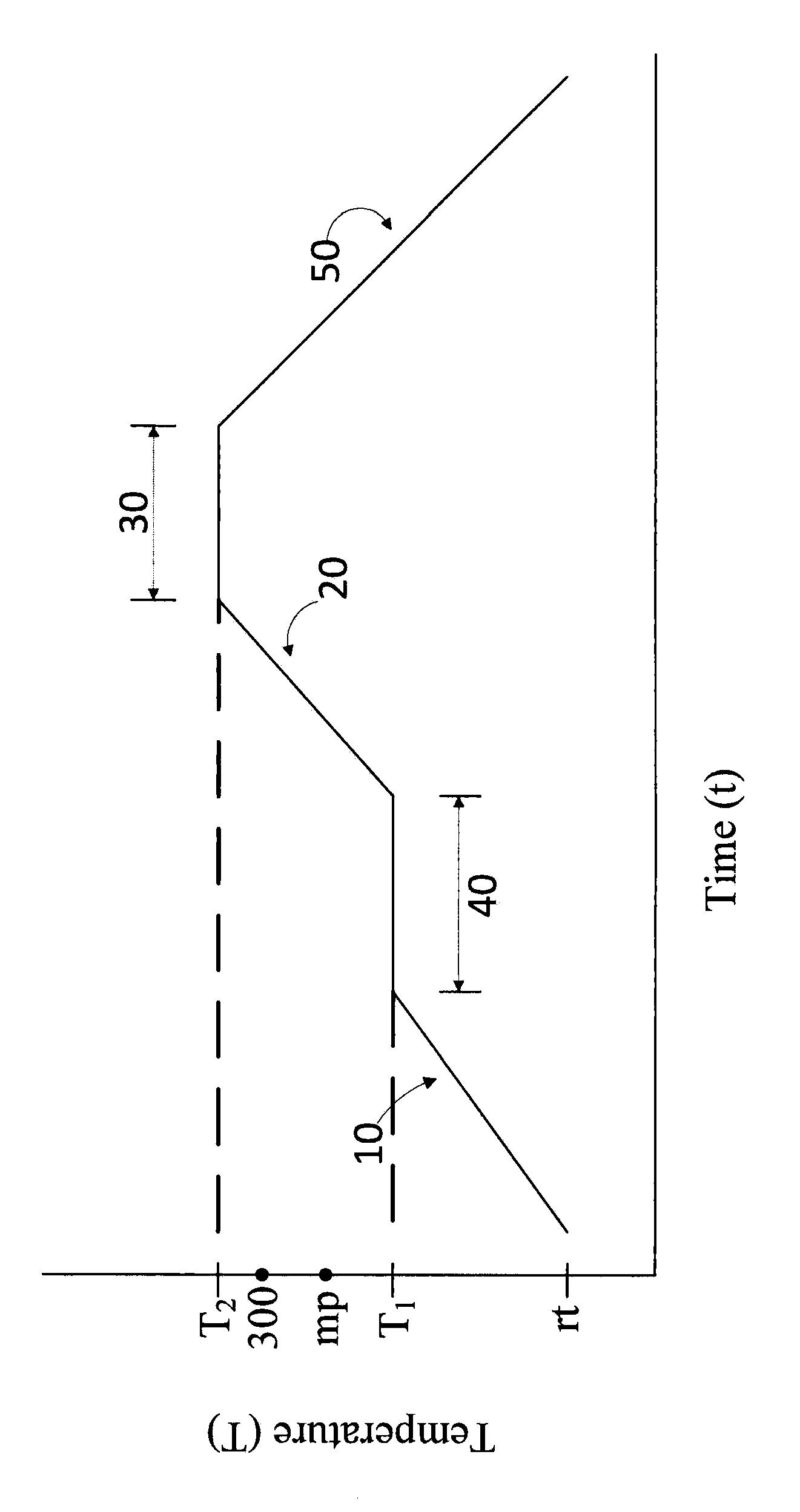Method for making ultra high molecular weight polyethylene
a polyethylene and molecular weight technology, applied in the field of making ultra high molecular weight polyethylene, can solve the problems of increasing the concentration of free radicals in the bulk polymer, reducing the physical properties of the implant bearing component made from the polymer, and treating above the melt temperature has the disadvantage of lowering the physical properties of the implant bearing component. , to achieve the effect of reducing or eliminating cavitation and suitability
- Summary
- Abstract
- Description
- Claims
- Application Information
AI Technical Summary
Benefits of technology
Problems solved by technology
Method used
Image
Examples
example 1
Heating at 300° C., without Radial Constraint
[0086]In a laboratory oven, the following UHMWPE consolidated bars were placed on the top shelf, five GUR 1050 bars of diameter 3.75 inches and two GUR 1020 bars of diameter 3.25 inches; on the second shelf, five GUR 1020 bars of diameter 3 inches and three GUR 1020 bars of diameter 3.25 inches; and on the third shelf, five GUR 1050 bars of 3-inch diameter and five GUR bars of 2.625 inch diameter.
[0087]The consolidated UHMWPE bars were heated with the following oven program.[0088]Purge with nitrogen: 30 min at 25°[0089]Ramp to 40° C. over 30 minutes[0090]Hold at 40° C. for 52 hours (so it starts Sunday night)[0091]Ramp to 120° C. over 2 hours[0092]Hold at 120° C. for 8 hours[0093]Ramp to 300° C. over 2 hours[0094]Hold at 300° C. over 10 hours[0095]Ramp down to 40° C. over 2 hrs 3 mins (˜2° C. / min)[0096]Hold at 40° C. for 6 hours[0097]Cool to room temperature
[0098]The bars were removed from the oven after the final cooling step and cut in ...
example 2
Heating at 320° C. without Radial Constraint
[0100]Five GUR 1020 bars of diameter 3¾ inch (minimum length of 5 inches) and five pieces of GUR 1020 one inch thick (i.e., disks of diameter 3¾ inches and length 1 inch) were subjected to the following heating protocol in a laboratory oven.[0101]1. Purge with nitrogen gas at room temperature (30 min)[0102]2. Ramp to 40° C. over 30 min[0103]3. Hold at 40° C. for a time determined by desired completion time[0104]4. Ramp to 120° C. over 2 hrs[0105]5. Hold at 120° C. for 8 hours[0106]6. Heat to 320° C. over 2 hrs 15 mins[0107]7. Hold at 320° C. for 10 hours[0108]8. Ramp down to 40° C. at 2° C. / min (2 hrs 20 min)[0109]9. Hold at 40° C. for 6 hours (min)[0110]10. End
Parts were cut in half (lengthwise) and cavitations were noted.
example 3
Pressure Heat Treating with Isostatic Pressure
[0111]A one-inch thick 3¾ inch diameter UHMWPE puck was placed in a pressure vessel where the temperature and pressure were increased to 320 C and 15,000 psi respectively. The temperature and pressure was held for 10 hours. The temperature was cooled to 40 C. The pressure was allowed to drop with the temperature to around 7,000 psi.
[0112]Isostatic pressure did not prevent cavitation. Instead of relatively large, elliptical voids, the bulk of the isostatically pressurized puck was riddled with small voids that made the polyethylene look porous like a kitchen sponge.
PUM
| Property | Measurement | Unit |
|---|---|---|
| Temperature | aaaaa | aaaaa |
| Temperature | aaaaa | aaaaa |
| Time | aaaaa | aaaaa |
Abstract
Description
Claims
Application Information
 Login to View More
Login to View More - R&D
- Intellectual Property
- Life Sciences
- Materials
- Tech Scout
- Unparalleled Data Quality
- Higher Quality Content
- 60% Fewer Hallucinations
Browse by: Latest US Patents, China's latest patents, Technical Efficacy Thesaurus, Application Domain, Technology Topic, Popular Technical Reports.
© 2025 PatSnap. All rights reserved.Legal|Privacy policy|Modern Slavery Act Transparency Statement|Sitemap|About US| Contact US: help@patsnap.com


